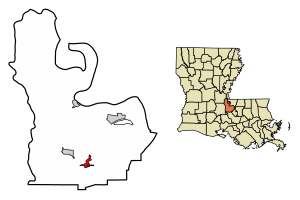Livonia, Louisiana facts for kids
Quick facts for kids
Livonia, Louisiana
|
|
|---|---|
|
Town
|
|
| Town of Livonia | |

Location of Livonia in Pointe Coupee Parish, Louisiana.
|
|

Location of Louisiana in the United States
|
|
| Country | United States |
| State | Louisiana |
| Parish | Pointe Coupee |
| Area | |
| • Total | 1.89 sq mi (4.90 km2) |
| • Land | 1.89 sq mi (4.90 km2) |
| • Water | 0.00 sq mi (0.00 km2) |
| Elevation | 26 ft (8 m) |
| Population
(2020)
|
|
| • Total | 1,212 |
| • Density | 639.92/sq mi (247.11/km2) |
| Time zone | UTC-6 (CST) |
| • Summer (DST) | UTC-5 (CDT) |
| ZIP code |
70755
|
| Area code(s) | 225 |
| GNIS feature ID | 543403 |
| FIPS code | 22-44690 |
Livonia (pronounced Le Vone ya) is a town in Pointe Coupee Parish, Louisiana, United States. It's a part of the larger Baton Rouge area. In 2020, about 1,212 people lived there.
The town has its own police department, the Livonia Police Department. A well-known person from Livonia is Rick Ward, III. He was born in Livonia and serves as a State Senator for District 17. A State Senator is someone elected to help make laws for the state.
Contents
History of Livonia
Early Native American History
Long ago, the area where Livonia is now was home to several American Indian tribes. These included the Chitimacha, Houma, Tunica-Biloxi, Attakapas, and Coushatta people.
One important historical site is the conical Livonia Mound. This mound is a special type of burial site built by ancient people. It is the tallest of 10 remaining Indian burial mounds in Pointe Coupee Parish. The Livonia Mound is about 165 feet wide at its base and nearly 31 feet tall. Scientists believe it was built during the Coles Creek archaeological culture period, which was between 400 AD and 1100 AD. You can find the mound near La 77 and La 78, close to Bayou Grosse Tête.
Colonial Times and French Influence
From 1699 to 1763, the Livonia area was part of a larger region called Louisiana, ruled by France. Then, in 1763, France gave the area to Spain. Spain controlled it until 1800, when Napoleon took Louisiana back for France.
Many French Canadians, also known as Acadians, moved to Louisiana. Most of them came between 1755 and 1764 after they were forced to leave their homes in Acadia (now part of Canada). You can still see French culture in Livonia today. For example, in 2000, about 5.6% of the people in Pointe Coupee Parish spoke French, Cajun French, or Louisiana Creole French. In 1803, the United States bought this land from France as part of the Louisiana Purchase.
How Livonia Got Its Name
The first post office in Livonia opened in 1846. The first postmaster, James B. Johnson, named the town after his hometown, Livonia, Pennsylvania.
Geography of Livonia
Livonia is located at 30°33′37″N 91°33′1″W / 30.56028°N 91.55028°W. The town covers a total area of about 1.8 square miles (4.9 square kilometers). All of this area is land, with no large bodies of water within the town limits.
Population and People
| Historical population | |||
|---|---|---|---|
| Census | Pop. | %± | |
| 1960 | 430 | — | |
| 1970 | 611 | 42.1% | |
| 1980 | 980 | 60.4% | |
| 1990 | 970 | −1.0% | |
| 2000 | 1,339 | 38.0% | |
| 2010 | 1,442 | 7.7% | |
| 2020 | 1,212 | −16.0% | |
| U.S. Decennial Census | |||
The table below shows the different groups of people living in Livonia as of 2020. This information comes from the 2020 United States census.
| Race | Number | Percentage |
|---|---|---|
| White (non-Hispanic) | 996 | 82.18% |
| Black or African American (non-Hispanic) | 120 | 9.9% |
| Native American | 2 | 0.17% |
| Other/Mixed | 52 | 4.29% |
| Hispanic or Latino | 42 | 3.47% |
In 2020, there were 1,212 people living in Livonia. These people lived in 572 different households, and 323 of these were families.
Education in Livonia
Local School
The main school in the town is Livonia High School. It serves the students in the Livonia area.
Culture and Events
Livonia is known for its annual Lions Club Mardi Gras parade. This fun event takes place the weekend before Mardi Gras Day. People gather to watch colorful floats and enjoy the festive atmosphere.
A surprising visitor to Livonia was Edward VIII, who was once the Duke of Windsor. He visited the town in 1950 by train, after attending the Mardi Gras celebration in New Orleans, Louisiana.
See also
 In Spanish: Livonia (Luisiana) para niños
In Spanish: Livonia (Luisiana) para niños

